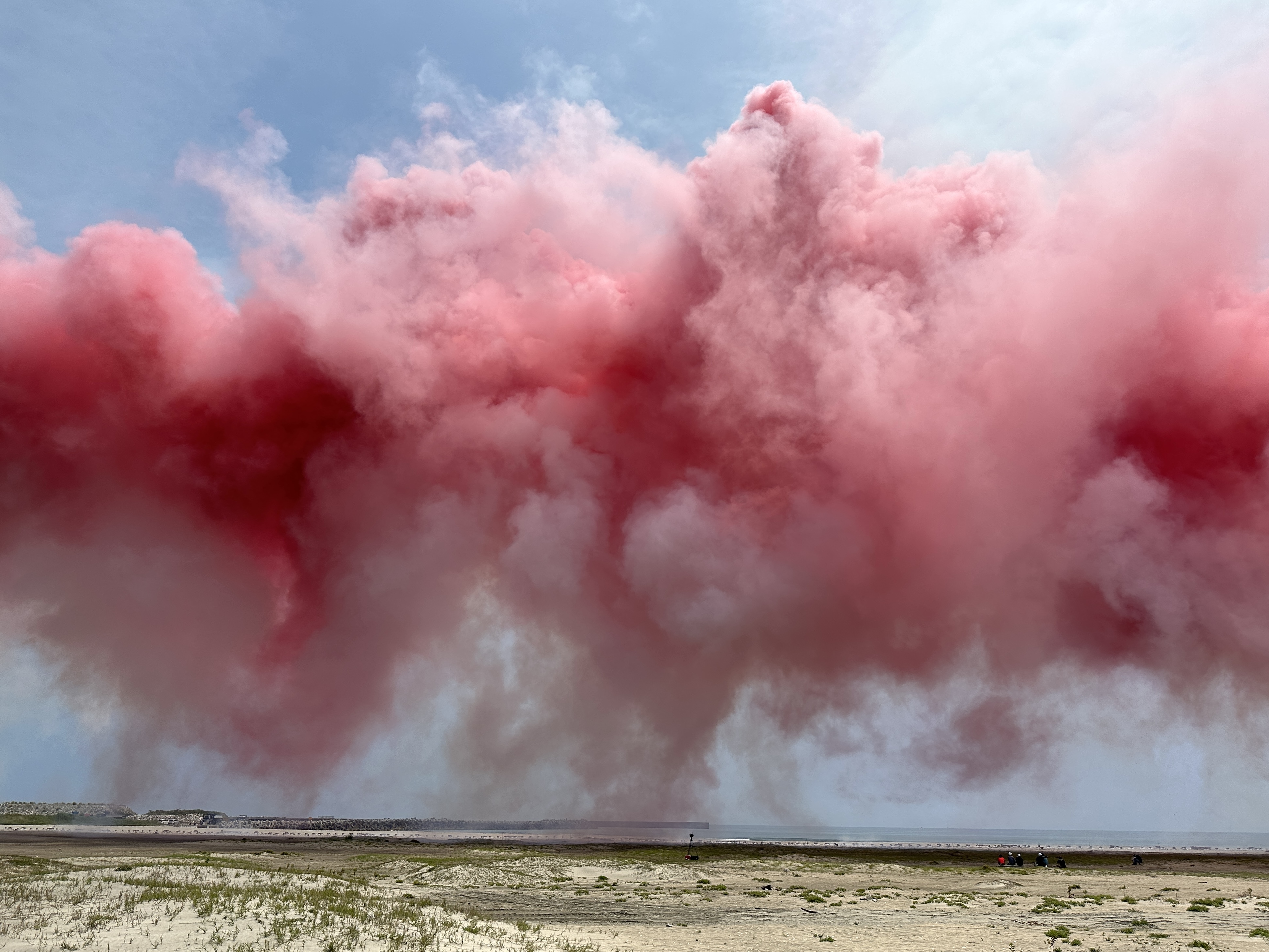Sakura Blooms in the Sky: Daytime Firework Event by Cai Guo-Qiang at Fukushima Prefecture
“When the Sky Blooms with Sakura” Photo by Tokyo Art Beat
On June 26, internationally renowned contemporary artist Cai Guo-Qiang presented the When the Sky Blooms with Sakura daytime fireworks event along the Yotsukura coastline in Iwaki City, Fukushima Prefecture. The cloudy weather cleared shortly before the event, and the vibrant fireworks blossomed in unison with the audience’s cheering. Commissioned by Saint Laurent, this special event was held as a prelude to the large-scale solo exhibition Cai Guo-Qiang: Ramble in the Cosmos - From Primeval Fireball Onward, opening on June 29 at The National Art Center, Tokyo.

Cai Guo-Qiang was born in Quanzhou, China, in 1957. Using gunpowder as his artistic medium and with an interest in Eastern philosophies and contemporary social issues, Cai has presented large-scale paintings, installations, and outdoor explosion projects worldwide. Since 1995, he has been based in New York and has received numerous awards, including the Golden Lion at the Venice Biennale in 1999, the Hiroshima Art Prize in 2007, and the Praemium Imperiale in Honor of Prince Takamatsu in 2012.
The fireworks program featured “Horizon - White Chrysanthemum” in memory of the victims of the Great East Japan Earthquake, “White Waves” and “Black Waves” representing the tsunami, “Monument” representing a memorial stone for the victims, and “Cherry Blossoms in Sky” and “Cherry Blossom Scroll” resembling cherry blossom petals.
400mにおよぶ花火🎆
— Tokyo Art Beat (@TokyoArtBeat_JP) June 26, 2023
国立新美術館で6月29日に始まる「蔡國強 宇宙遊 ―〈原初火球〉から始まる」。これに先駆け、サンローランのコミッションで福島県いわき市にて白天花火《満天の桜が咲く日》が行われました。 pic.twitter.com/kcOSfCvesX
The friendship between Cai Guo-Qiang and Iwaki citizens
It is no coincidence that the performance took place on the coast of Iwaki City, as the connection between Cai and the citizens runs deep. Cai Guo-Qiang lived in Japan for approximately nine years, from December 1986 to September 1995, and Iwaki became a second home for his personal life and art. As a beginning artist, Cai and his wife, Hong Hong Wu, developed a close relationship with the citizens of Iwaki, which resulted in the formation of the “Executive Committee,” led by Tadashige Shiga, to support the creation of Cai’s artworks. Even after Cai moved to New York in 1995, friends in Iwaki regularly published “Cai Guo-Qiang Correspondence” to share his recent activities with the people of Iwaki.


In 1993, Cai moved to the Yotsukura town in Iwaki, and together with the members of the Executive Committee and many local volunteers, he organized the explosion event The Horizon from the Pan-Pacific: Project for Extraterrestrials No. 14 and his first solo exhibition at a public museum in Japan, Cai Guo-Qiang: From the Pan-Pacific (1994) at the Iwaki City Art Museum. Commissioned by Iwaki City Art Museum, The Horizon from the Pan-Pacific: Project for Extraterrestrials No. 14 was realized in the Pacific Ocean, offshore from Numanouchi to Yotsukura Beach. During the night, six gunpowder fuses, 5,000m each, ignited on the dark surface of the sea, drawing a line of fire on the horizon.
When the Sky Blooms with Sakura is the first major project by Cai in Iwaki in approximately 30 years. The head of the Executive Committee, Tadashige Shiga, expressed his excitement by saying, “Back then, I thought of him as my brother. Now he is famous all over the world, but he has returned to Iwaki.”

The Great East Japan Earthquake and “Project to Plant Ten Thousand Cherry Blossom Trees”
One cannot mention Iwaki without recalling the tremendous damage caused by the 2011 Great East Japan Earthquake and the nuclear power plant accident. In response, Cai immediately donated one of his works to a charity auction to support friends who lost their homes and help them rebuild. However, his friends suggested instead establishing the “Project to Plant Ten Thousand Cherry Blossom Trees,” explaining that “these cherry trees reflect a remorse that our generation built a nuclear power plant and caused a great disaster for future generations.” Strongly moved by the love for their hometown and sense of responsibility for the future, Cai joined them in planting the cherry blossom trees.
In 2001, Cai conceptualized the Snake Museum of Modern Art (SMoCA). Using wood that could no longer be sold because of radioactive contamination, his friends in Iwaki built a 160-meter-long art corridor that weaves like a dragon through a cherry blossom forest—inspired by this story, the fireworks in When the Sky Blooms with Sakura featured many “cherry blossom” motifs.

For hope and children’s smile
This event was initially scheduled to be held on the day of the opening ceremony of the 2021 Tokyo Olympics to celebrate the 10th anniversary of Iwaki’s recovery from the earthquake and tsunami, but it was canceled due to the pandemic outbreak. On June 26, however, Cai Guo-Qiang returned to Iwaki after 30 years.
The artwork confronts trauma through the Eastern philosophical ethos of “requiem” to inspire an indomitable spirit amid adversity and spread hope. Wondering about the reaction of the children gathered for the event, Cai commented, “I hope the kids will like it.” And indeed, the crowd cheered with every explosion that burst into the sky over the Yotsukura coast.


The fireworks event will premiere on Saint Laurent's official website on June 29 and will be projected on the screens of Times Square in New York, Piccadilly in London, The Grand Gateway in Shanghai, Shamao in Chengdu, Shinjuku and Harajuku in Tokyo.
Chiaki Noji
Chiaki Noji



